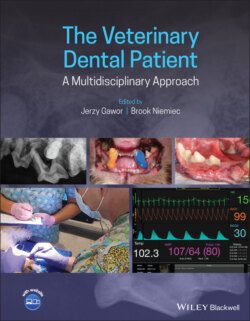Читать книгу The Veterinary Dental Patient: A Multidisciplinary Approach - Группа авторов - Страница 66
4.5.2 Oral Examination: The Conscious Patient
ОглавлениеA general health exam must be performed by the veterinarian. The entire animal should be examined, nose to tail. A thorough exam should include the eyes, ears, skin, heart, lung, and abdomen. If anesthesia is planned, it is highly recommended to perform blood and urine analysis.
In a well‐managed practice (i.e. one that effectively utilizes lay staff), the veterinary technician/nurse can perform the initial oral examinations on both the conscious and the anesthetized patient and report their findings to the veterinarian (Figure 4.8). The conscious exam is limited to olfactory, visual, and tactile examination.
Is the head symmetrical? Do both sides appear to be uniform or does one look different to the other? (Niemiec 2010) Is there swelling in any area of the mouth/head? If swelling appears below the eye, look for a fractured maxillary fourth premolar. Do the jaws appear symmetrical? If one side of the jaw is swollen or asymmetrical, rule out mandibular or tooth fractures, or oral masses.
Feel the head. Palpate the bones of the head, including the zygomatic arch and mandibles. Feel for the presence of abnormalities. Evaluate the lymph nodes, including the sublingual and submandibular nodes. Inflammation in the oral cavity can contribute to swelling of these nodes. The temporomandibular joint should also be palpated for indications of pain or discomfort.
A detailed oral exam should be performed prior to anesthesia, if possible. Check for occlusion, tooth fractures, gingival recession, and inflammation, as well as missing, supernumerary, or loose teeth. Count the teeth. This task can be difficult as not every patient is willing to allow a complete examination, especially if they are head shy or young. Each tooth should be evaluated for fractures, mobility, and the amount of plaque and calculus present.
Figure 4.8 Concious animal assessment.
While it is most important to evaluate the gingiva under general anesthesia when the gingival index and pocket depth can be evaluated, it is important too to observe the gingiva to determine a preliminary degree of periodontal inflammation. Healthy gingiva is pink with defined margins, while inflammation is indicated by red, swollen gums. Gingival recession or enlargement is a key element of periodontal disease and should be noted.
A complete examination can only be completed under general anesthesia, but examination of the conscious patient can yield vital information that can help create the initial treatment plan and client estimate (Figure 4.9).
